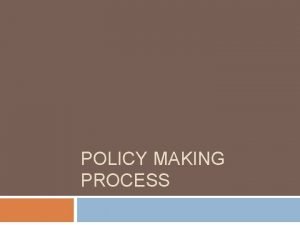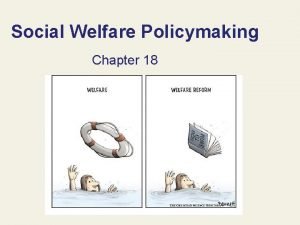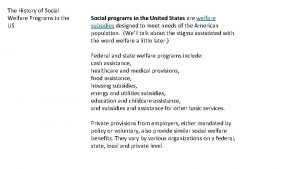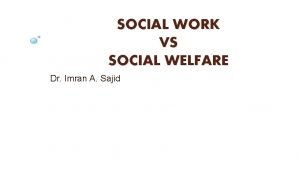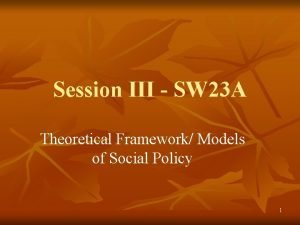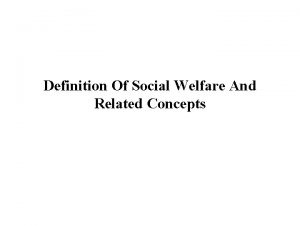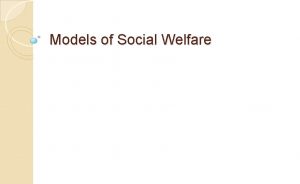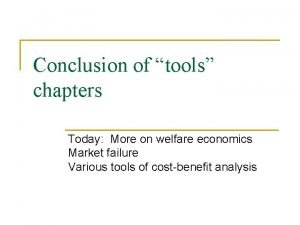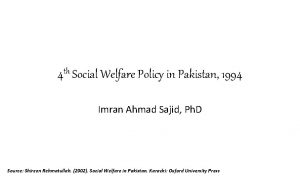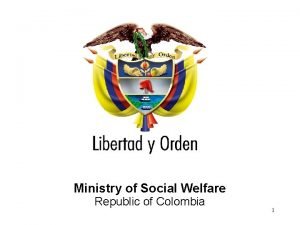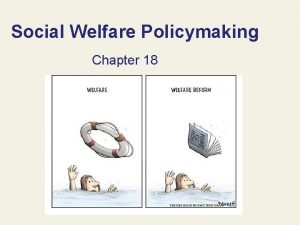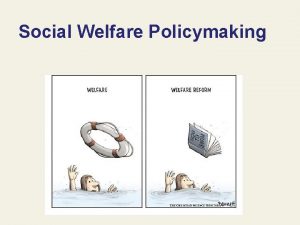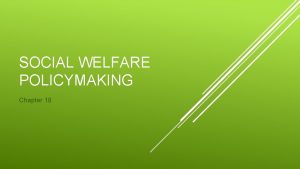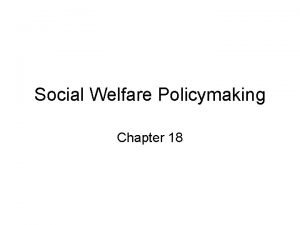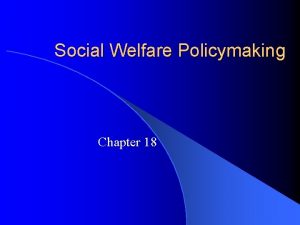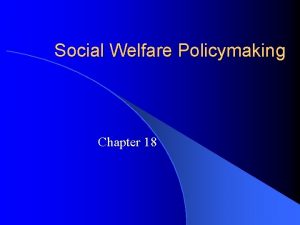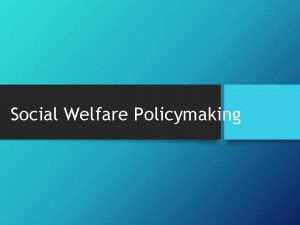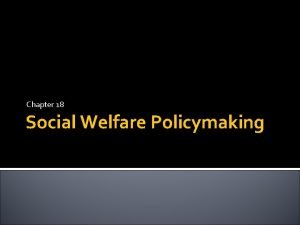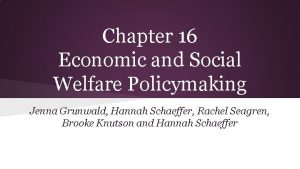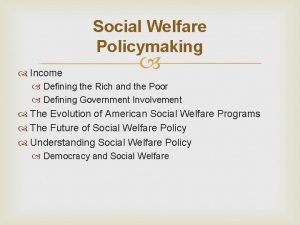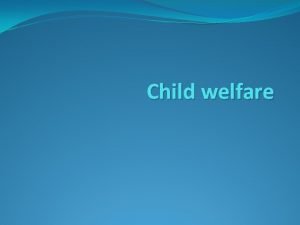Social Welfare Policymaking Chapter 17 Social Welfare Programs
















- Slides: 16

Social Welfare Policymaking Chapter 17

Social Welfare Programs • Two main types: • Entitlement programs: Government benefits that certain qualified individuals are entitled to by law, regardless of need. This includes Social Security and Medicare. • Means-tested programs: Government programs only available to individuals below the poverty line. This includes TANF and Medicaid.

Income, Poverty, and Public Policy • Income: amount of funds collected between any two points in time. • Wealth: amount of assets already owned.

Income, Poverty, and Public Policy • Poverty Line: what a family must spend for an “austere” standard of living. • In 2012, a family of three had a poverty line of just over $19, 000. • Many people move in and out of poverty in a year’s time. • There are high rates of poverty among unmarried women.

Income, Poverty, and Public Policy

Income, Poverty, and Public Policy • 125% of Poverty Line for family of four is $28, 800 • Equals less than $20 per day, per family member • From this amount all food, clothing, medical and entertainment costs must be paid • Average rent in the U. S. is $804, when subtracting this amount, this family must survive on $13 per day, person.

The Demographics of Poverty

Government Policies • Progressive tax: people with higher incomes pay a greater percentage. • Proportional tax: all people pay the same percentage of their income. • Regressive tax: the poor pay a higher percentage of their income than the rich

Government Policies Government Expenditures. • Transfer payments: benefits given by the government directly to individuals • Some transfer benefits are actual money. • Other transfer benefits are “in kind” benefits where recipients get a benefit without receiving actual money. • Some are entitlement programs, others are means-tested.

The Great Depression and the New Deal • The Great Depression led many citizens to want the government to help protect against economic downturns and causes of poverty beyond their control. • The Social Security Act of 1935 was the first major step by the federal government to help protect people against absolute poverty.

The Great Society • Johnson declared a “war on poverty. ” • Medicare, school-aid programs and welfare were created. • Other programs were designed to provide training and jobs, not just transfer payments.

Reagan and Changes to Welfare • Reagan played a lead role in getting attention on benefit programs. • Many programs had benefits reduced, and people were removed from benefit rolls. • Democrats worked to prevent cuts and protect the truly poor.

The Welfare Reform Act • Temporary Aid to Needy Families replaced Aid to Families with Dependent Children. • The new program put a 5 year limit on the amount of time a person could receive benefits. • It also gave the states money in a block grant to run their own welfare programs.

The Future of Social Security and Medicare • Social Security is running out of money • There are several plans to improve Social Security’s financial future • • Cut benefits Raise the retirement age Raise tax rates Allow people to invest on their own

The Future of Social Welfare Policy • Programs for the poor are not as popular as programs for the elderly. • The percentage of people in poverty has not changed significantly since the 1960’s. • But there is little agreement on if the programs help people in poverty or not.

The Future of Social Welfare Policy • Social Welfare Policy Elsewhere • Many industrialized nations have much more extensive social welfare programs than the U. S. • But the tax rates are higher in those countries than in the U. S. • Other countries (especially in the EU) are reforming their welfare programs. Cuts to social programs are called “austerity measures. ”
 Public policy process
Public policy process Examples of social welfare programs
Examples of social welfare programs Cpmcd full form
Cpmcd full form Welfare programs in the us
Welfare programs in the us All national programme list
All national programme list Social welfare vs social work
Social welfare vs social work Industrial achievement performance model
Industrial achievement performance model What is remedial model in social work
What is remedial model in social work Social welfare services definition
Social welfare services definition Social welfare models
Social welfare models Conclusion of welfare economics
Conclusion of welfare economics 2nd social welfare policy in pakistan
2nd social welfare policy in pakistan Social welfare
Social welfare Social welfare in colombia
Social welfare in colombia Ethics and social welfare
Ethics and social welfare Types of early childhood programs activity a chapter 2
Types of early childhood programs activity a chapter 2 Social thinking and social influence in psychology
Social thinking and social influence in psychology
